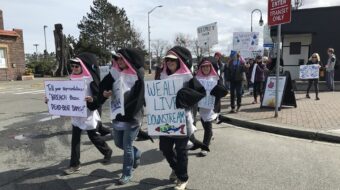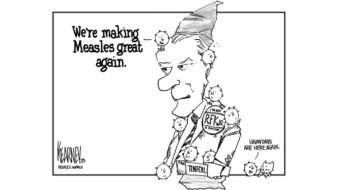
The gas leak in the Porter Ranch neighborhood of Los Angeles, California, which began Oct. 23 last year, has been confirmed as the worst methane disaster in U.S. history. The leak was halted on Feb. 18, but not before ravaging the atmosphere with roughly 100,000 tons of methane, leaving a carbon footprint larger than the Deepwater Horizon oil spill. Now, in a possible case of ‘better late than never,’ the Golden State is taking serious measures to curb methane emissions.
The leak, which originated in a large underground methane storage facility at Aliso Canyon, represents one more mark against the natural gas industry, and yet another wound inflicted upon the planet. The Southern California Gas Co., owner of the storage site, insisted there would be no long-term health effects on the nearby community, but residents’ complaints of headaches, nausea, and lethargy challenged that admission. The company has now stopped the leak by drilling a relief well that intercepted the base of the damaged one, which they have now begun the process of permanently sealing.
However, these efforts cannot undo the damage that came as a result of this, a widely underreported disaster that could be one of the worst environmental incidents in years. “Aliso Canyon will be, certainly, the biggest single source of the year” for methane, said Stephen Conley of the University of California, Davis and the journal Scientific Aviation. “It’s definitely a monster.” He and other scientists performed a measurement of the methane output, which were then sent to the Air Resources Board – the clean air agency of the state of California. “It was 20 times larger than anything we’d ever measured,” he added. “And it was obvious that there wasn’t anything wrong with the instruments [we used]. This was just a huge event.”
So now, the Air Resources Board has taken the sobering result of Conley’s analysis, and plans to do something about it. The agency is taking regulatory action to cut methane output by the oil and gas industry. The new proposed rules would prohibit intentional emissions (venting), require quarterly leak inspections of facilities, and include measures to prevent worsening air quality caused by oil and gas activity. If enacted, the rules would be the strongest of their kind in the country, outpacing similar measures from the Obama administration and other states.
“In light of the Aliso Canyon disaster, the case for strong national rules to limit methane pollution from both current and future oil and gas sites has never been clearer,” said Environmental Defense Fund (EDF) president Fred Krupp. “California is showing that there is a sensible way to reduce these emissions now. Across the nation, the oil and gas industry emits eight million tons a year, which amounts to the same climate impact as the annual emissions from 160 coal plants during the next two decades.”
“Keeping gas in the pipes where it belongs protects public and environmental health,” added the EDF’s Director of California Oil and Gas, Tim O’Connor. “Many of the state’s oil and gas facilities are old and decrepit. In light of the science on methane and equipment leaks and the events at Aliso Canyon, this long-awaited proposal for increased oversight and maintenance requirements couldn’t have come sooner.”
“I hope that one of the lessons learned here is that we need to have some sort of a rapid response methodology in place,” Conley concluded. When there’s a disaster like this, “somebody needs to be there in hours, not weeks.”
Photo: Environmental activist group Save Porter Ranch protests the Porter Ranch leak. On the right is the organization’s president, Matt Pakucko. | Brian Melley/AP











